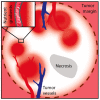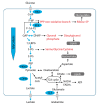Flexibility and Adaptation of Cancer Cells in a Heterogenous Metabolic Microenvironment
- PMID: 33540663
- PMCID: PMC7867260
- DOI: 10.3390/ijms22031476
Flexibility and Adaptation of Cancer Cells in a Heterogenous Metabolic Microenvironment
Abstract
The metabolic microenvironment, comprising all soluble and insoluble nutrients and co-factors in the extracellular milieu, has a major impact on cancer cell proliferation and survival. A large body of evidence from recent studies suggests that tumor cells show a high degree of metabolic flexibility and adapt to variations in nutrient availability. Insufficient vascular networks and an imbalance of supply and demand shape the metabolic tumor microenvironment, which typically contains a lower concentration of glucose compared to normal tissues. The present review sheds light on the recent literature on adaptive responses in cancer cells to nutrient deprivation. It focuses on the utilization of alternative nutrients in anabolic metabolic pathways in cancer cells, including soluble metabolites and macromolecules and outlines the role of central metabolic enzymes conferring metabolic flexibility, like gluconeogenesis enzymes. Moreover, a conceptual framework for potential therapies targeting metabolically flexible cancer cells is presented.
Keywords: adaptability; cancer; gluconeogenesis; heterogeneity; metabolic microenvironment.
Conflict of interest statement
The authors declare no conflict of interests.
Figures




Similar articles
-
Gluconeogenesis in cancer cells - Repurposing of a starvation-induced metabolic pathway?Biochim Biophys Acta Rev Cancer. 2019 Aug;1872(1):24-36. doi: 10.1016/j.bbcan.2019.05.006. Epub 2019 May 30. Biochim Biophys Acta Rev Cancer. 2019. PMID: 31152822 Free PMC article. Review.
-
Immunometabolic Checkpoints of Treg Dynamics: Adaptation to Microenvironmental Opportunities and Challenges.Front Immunol. 2019 Aug 27;10:1889. doi: 10.3389/fimmu.2019.01889. eCollection 2019. Front Immunol. 2019. PMID: 31507585 Free PMC article. Review.
-
Tumor Microenvironment: A Metabolic Player that Shapes the Immune Response.Int J Mol Sci. 2019 Dec 25;21(1):157. doi: 10.3390/ijms21010157. Int J Mol Sci. 2019. PMID: 31881671 Free PMC article. Review.
-
Combination strategies to target metabolic flexibility in cancer.Int Rev Cell Mol Biol. 2022;373:159-197. doi: 10.1016/bs.ircmb.2022.03.001. Epub 2022 Apr 28. Int Rev Cell Mol Biol. 2022. PMID: 36283766 Review.
-
Flexibility in metabolism bestows tenacious viability on cancer.Life Sci. 2018 Sep 1;208:20-25. doi: 10.1016/j.lfs.2018.07.008. Epub 2018 Jul 6. Life Sci. 2018. PMID: 30146015 Review.
Cited by
-
Salubrinal Enhances Cancer Cell Death during Glucose Deprivation through the Upregulation of xCT and Mitochondrial Oxidative Stress.Biomedicines. 2021 Aug 28;9(9):1101. doi: 10.3390/biomedicines9091101. Biomedicines. 2021. PMID: 34572286 Free PMC article.
-
Cisplatin and Starvation Differently Sensitize Autophagy in Renal Carcinoma: A Potential Therapeutic Pathway to Target Variegated Drugs Resistant Cancerous Cells.Cells. 2024 Mar 7;13(6):471. doi: 10.3390/cells13060471. Cells. 2024. PMID: 38534315 Free PMC article.
-
Synchronized, Spontaneous, and Oscillatory Detachment of Eukaryotic Cells: A New Tool for Cell Characterization and Identification.Adv Sci (Weinh). 2022 Aug;9(24):e2200459. doi: 10.1002/advs.202200459. Epub 2022 Jul 3. Adv Sci (Weinh). 2022. PMID: 35780480 Free PMC article.
-
Altered metabolism in cancer: insights into energy pathways and therapeutic targets.Mol Cancer. 2024 Sep 18;23(1):203. doi: 10.1186/s12943-024-02119-3. Mol Cancer. 2024. PMID: 39294640 Free PMC article. Review.
-
How Warburg-Associated Lactic Acidosis Rewires Cancer Cell Energy Metabolism to Resist Glucose Deprivation.Cancers (Basel). 2023 Feb 23;15(5):1417. doi: 10.3390/cancers15051417. Cancers (Basel). 2023. PMID: 36900208 Free PMC article. Review.
References
Publication types
MeSH terms
Grants and funding
LinkOut - more resources
Full Text Sources
Other Literature Sources
Medical

